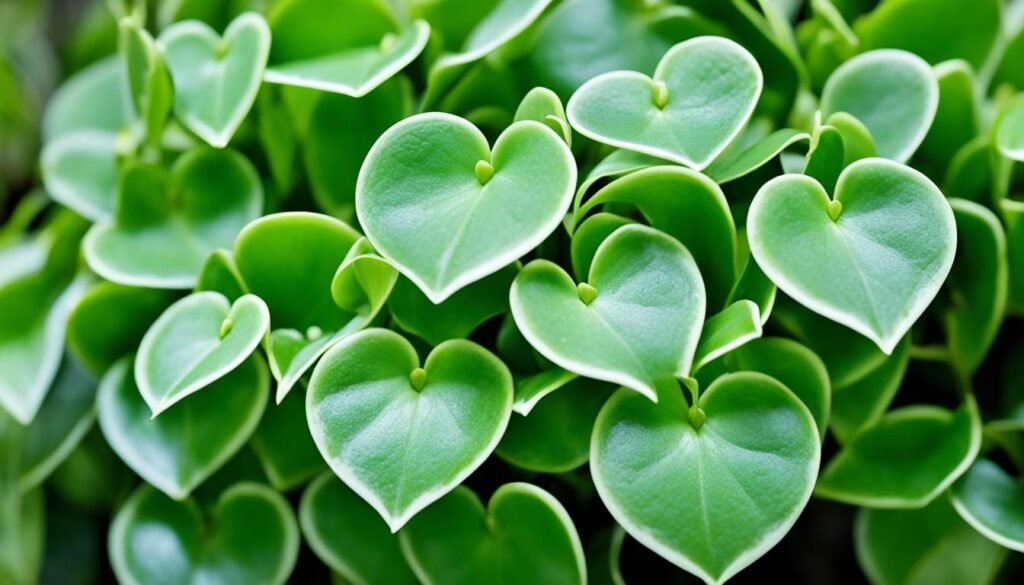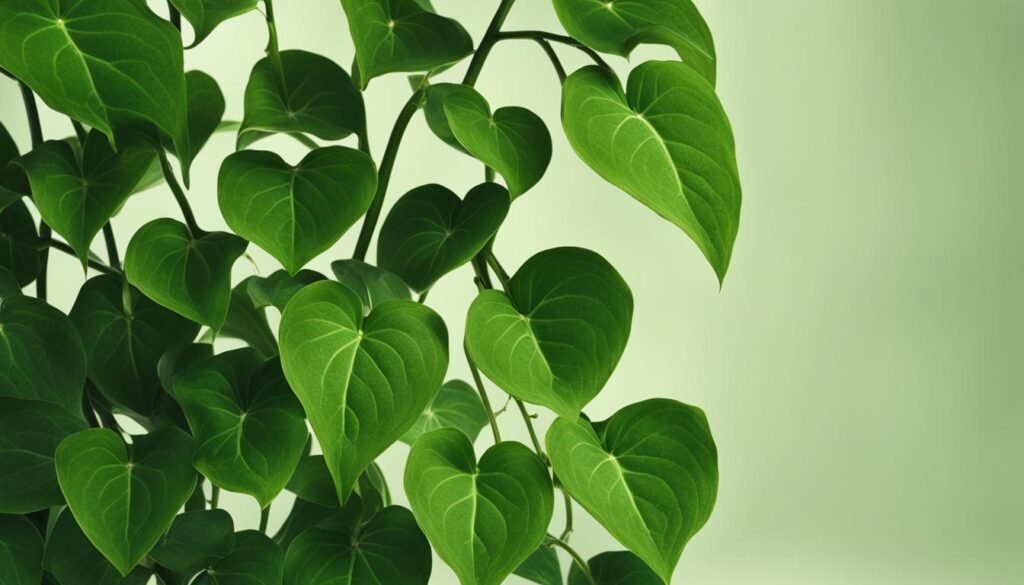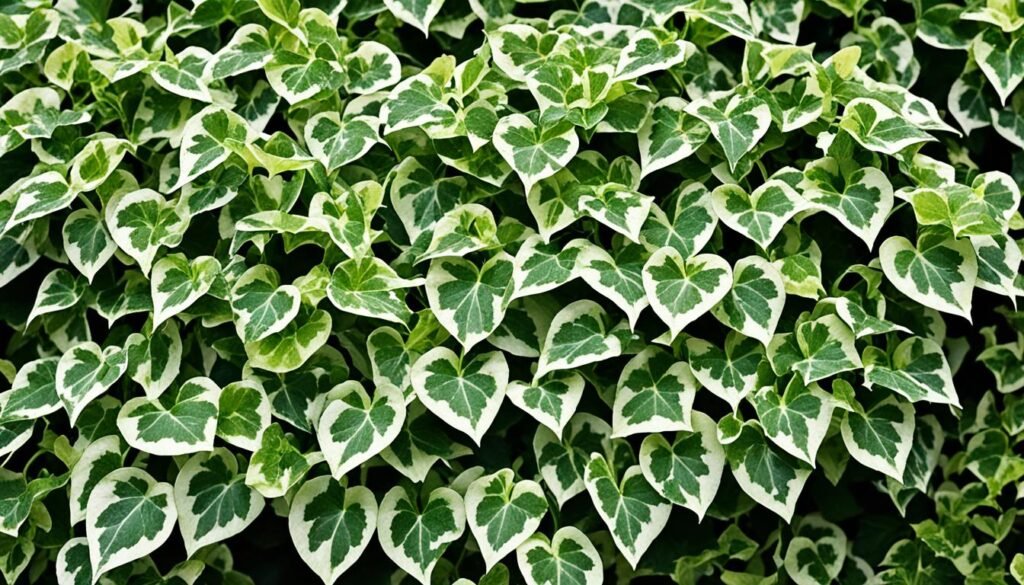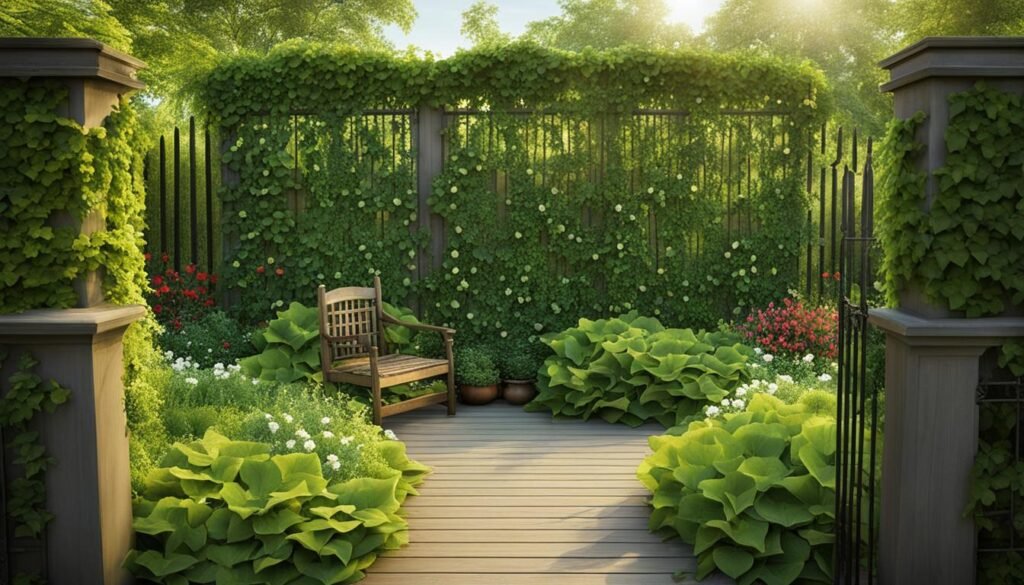Vines with heart-shaped leaves can bring a romantic charm whether you grow them indoors or outdoors. In this article, we will explore a variety of lovely vines with heart-shaped leaves that can add romance and lushness to your garden or indoor oasis. These vines come in different species such as the heartleaf philodendron, sweetheart hoya, ceropegia woodii, chain of hearts plant, and devil’s ivy. They are easy to care for and make excellent indoor vine plants or trailing houseplants. Whether you prefer the classic green foliage or the variegated varieties, there’s a heart-shaped vine that will suit your preferences. Let’s dive in and discover these charming vines!
Key Takeaways:
- Vines with heart-shaped leaves add a romantic charm to gardens and indoor spaces.
- Heartleaf philodendron, sweetheart hoya, ceropegia woodii, chain of hearts plant, and devil’s ivy are popular heart-shaped vine options.
- These vines are easy to care for and make excellent indoor vine plants or trailing houseplants.
- Choose between classic green foliage or variegated varieties depending on your preferences.
- Let’s explore these charming vines and enhance your garden or indoor oasis.
Heartleaf Philodendron (Philodendron hederaceum)
The heartleaf philodendron, also known as Philodendron hederaceum, is a popular houseplant with heart-shaped leaves. It is a versatile vine that can be grown indoors as an indoor vine plant or as a trailing houseplant. The leaves are typically glossy and dark green, but there are also variegated varieties available.
The heartleaf philodendron is easy to care for and can tolerate low light conditions, making it a great choice for beginner plant enthusiasts. It can be grown in a pot or hanging basket and will cascade beautifully as it grows.
Whether you place it on a shelf, let it trail down from a bookshelf, or hang it in a macrame hanger, the heartleaf philodendron adds a touch of elegance to any space. Its heart-shaped leaves are not only aesthetically pleasing but also a symbol of love and affection, making it a perfect addition to your indoor oasis.
The heartleaf philodendron is a versatile plant that can adapt to a range of conditions, including low light and average room temperatures. However, it thrives in bright, indirect light and moderate humidity. It is important to allow the soil to dry slightly between waterings to prevent overwatering, as this can lead to root rot.
This indoor vine plant requires minimal maintenance and can quickly become a focal point in your home. With its cascading foliage and heart-shaped leaves, the heartleaf philodendron brings a calming and natural element to any living space. Whether you are a seasoned plant enthusiast or a beginner, this trailing houseplant will add beauty and serenity to your indoor jungle.
“The heartleaf philodendron is a classic indoor plant that never goes out of style. Its heart-shaped leaves are charming, and its trailing growth habit adds a touch of elegance to any room.”
Sweetheart Hoya (Hoya Kerrii)
The sweetheart hoya, or Hoya Kerrii, is a delightful vine with heart-shaped leaves that make it a perfect gift for loved ones. It features showy and small pink-white blooms in the fall and summer, adding an extra touch of romance. This vine can be grown as an indoor vine plant or a trailing houseplant. It thrives in acidic or neutral soil and prefers partial sunlight. The sweetheart hoya is known for its resilience and can tolerate periods of neglect, making it a suitable choice for busy plant owners.

| Growth Habit | Light Requirements | Watering Needs | Soil Type | Special Features |
|---|---|---|---|---|
| Trailing vine | Partial sunlight | Regular watering | Acidic or neutral | Showy pink-white blooms |
The sweetheart hoya, with its heart-shaped leaves and lovely blooms, adds a romantic touch to any indoor or outdoor space. Its adaptability and resilience make it a low-maintenance choice for plant enthusiasts. Whether you choose to grow it as an indoor vine plant or a trailing houseplant, the sweetheart hoya will bring beauty and romance to your home or garden.
Ceropegia Woodii (Chain of Hearts Plant)
I am excited to introduce you to the enchanting Ceropegia Woodii, commonly known as the Chain of Hearts Plant. This unique trailing vine features delicate heart-shaped leaves that cascade down, resembling a beautiful chain. It is the perfect addition to your indoor vine plant collection or trailing houseplants.
The Ceropegia Woodii is a versatile plant that can thrive in a variety of light conditions, making it a great choice for any home. Whether you have a brightly lit room or a space with lower light levels, this vine will adapt and continue to flourish. Its ability to withstand different light conditions makes it an excellent option for those who may not have access to abundant natural light.
The Chain of Hearts Plant also features delicate purple stems that add visual interest to its overall appearance. As the vine grows and cascades down, the contrast between the heart-shaped leaves and the purple stems creates a stunning display. It will be sure to catch the eye of anyone who enters your space.
One of the standout qualities of the Ceropegia Woodii is its low-maintenance nature. It doesn’t require frequent watering or complicated care routines, making it an ideal choice for busy plant owners or those new to plant care. This vine can be grown in a hanging planter, allowing it to gracefully dangle, or on a trellis, offering a unique climbing display.
With its heart-shaped leaves and cascading growth habit, the Ceropegia Woodii brings a touch of romance and beauty to any space. Whether you let it trail gracefully from a hanging planter or guide it along a trellis, this plant is a stunning addition to your indoor vine plant collection or trailing houseplants.
| Plant | Light Requirements | Watering Needs | Special Care |
|---|---|---|---|
| Ceropegia Woodii | Adaptable to various light conditions | Moderate watering, allow soil to dry between waterings | Avoid overwatering, prune occasionally to maintain shape |
Devil’s Ivy (Epipremnum aureum)
When it comes to indoor vine plants and trailing houseplants, devil’s ivy is a top choice that adds a touch of vibrance and beauty to any space. Also known as Epipremnum aureum, devil’s ivy features heart-shaped leaves that bring a unique charm to your indoor oasis. Not only is it visually appealing, but it is also a fast-growing vine that can quickly trail or climb walls, making it a versatile option for vertical gardening. Whether you want to hang it from a planter or train it to climb a trellis, devil’s ivy creates a stunning cascading effect that adds a sense of lushness to your home.
One of the remarkable qualities of devil’s ivy is its adaptability to different light conditions. It can thrive in low light areas, making it an excellent choice for those rooms where natural sunlight is limited. You can place it in the corner of your living room or office, and it will still thrive and brighten up the space with its heart-shaped leaves.

Aside from its aesthetic appeal, devil’s ivy is also known for its air-purifying properties. It can help remove toxins from the indoor air, including xylene, formaldehyde, and benzene, which are commonly found in household products and can have negative effects on our health. By having devil’s ivy as part of your indoor vine plant collection, you not only enhance the visual appeal of your space but also improve the air quality, creating a healthier and more pleasant environment.
So, whether you are a seasoned plant enthusiast or just starting your indoor gardening journey, devil’s ivy is a fantastic choice. Its heart-shaped leaves, adaptability, and air-purifying benefits make it a must-have for any indoor space.
Variegated Ivy (Cissus discolor)
Variegated ivy, scientifically known as Cissus discolor, is a beautiful vine with heart-shaped leaves that display a frosty silver pattern and red undersides. This trailing houseplant is perfect for adding a touch of elegance and texture to any indoor space. It prefers bright but indirect light and can be grown in a hanging planter or on a trellis. The variegated ivy adds a unique aesthetic with its striking foliage and is sure to be a conversation starter.

| Benefits of Variegated Ivy | Care Guide for Variegated Ivy |
|---|---|
|
|
Heartleaf Plant (Hedera helix)
The heartleaf plant, scientifically known as Hedera helix, is a classic choice for indoor vine plants or trailing houseplants. Commonly referred to as English ivy, this vine is cherished for its heart-shaped leaves and vigorous growth. Its cascading stems add a touch of greenery and elegance to any room.
The heartleaf plant thrives in bright, indirect light conditions, making it suitable for various indoor spaces. It is a low-maintenance plant that requires regular watering to keep the soil consistently moist. However, ensure not to overwater to avoid root rot.
If you choose to grow the heartleaf plant indoors, it can be placed in pots or hanging baskets. Hanging baskets allow its trailing vines to gracefully drape, while pots can create a compact and lush display. You can also let the heartleaf plant climb up trellises or walls to add vertical interest to your space, especially in areas with ample natural light.
One important consideration when growing the heartleaf plant is its invasive nature in outdoor garden settings. It is best to confine this vine to indoor or controlled environments to prevent it from taking over your garden. However, if you have a specific area in mind where you want it to thrive outdoors, ensure you monitor its growth and take necessary precautions to prevent it from spreading uncontrollably.

The heartleaf plant adds a touch of timeless charm and lushness to any space. Its heart-shaped leaves symbolize love and make it an excellent choice for creating a romantic atmosphere. Whether placed on a shelf, hanging from a basket, or climbing up a trellis, this beautiful vine plant adds a touch of elegance and nature’s beauty to any room.
“The heartleaf plant cascades gracefully, filling your space with vibrant green foliage and its heart-shaped leaves create a visual representation of the love and beauty it brings.”
| Plant Care | Heartleaf Plant (Hedera helix) |
|---|---|
| Light | Bright, indirect light |
| Watering | Regular watering, keeping the soil consistently moist |
| Placement | Pots, hanging baskets, or climbing on trellises |
| Invasiveness | Considered invasive in outdoor garden settings; best grown indoors or in controlled environments |
Why Choose the Heartleaf Plant?
- The heartleaf plant is a classic choice for indoor vine plants or trailing houseplants.
- Its heart-shaped leaves symbolize love and add a touch of romance to your space.
- This vine plant is easy to care for and requires minimal maintenance.
- It thrives in bright, indirect light conditions.
- The heartleaf plant can be grown in a variety of containers, allowing for versatile placement.
- Its trailing vines create a visually stunning display when placed in hanging baskets or allowed to climb on trellises.
Vines with Heart-Shaped Leaves for Outdoor Gardens
While many of the vines discussed so far are excellent choices for indoor environments, there are also several stunning vines with heart-shaped leaves that are perfect for outdoor gardens. These climbing plants can be trained to grow on trellises, fences, or pergolas, adding a touch of romance and beauty to your garden decor.
One notable choice is the Dutchman’s pipe (Aristolochia durior), which offers unusual large blooms and heart-shaped leaves. This vine can create a stunning focal point in any garden, with its unique and captivating appearance.

Another beautiful option is the Redbud ‘Hearts Of Gold’ (Cercis canadensis), which features golden-green heart-shaped leaves and pink flowering clusters. This vine adds a touch of elegance and color to any outdoor space, creating a vibrant and inviting atmosphere.
These vines with heart-shaped leaves not only enhance the aesthetic appeal of your outdoor gardens but also provide a unique addition to your garden decor. Whether you’re looking to create a romantic setting or add visual interest to your outdoor space, these vines are sure to impress.
How to Care for Vines with Heart-Shaped Leaves
To ensure the health and vitality of your vines with heart-shaped leaves, it is essential to provide them with proper care. Whether you choose to grow them indoors as houseplants or outdoors in your garden, there are some general maintenance tips to keep in mind. This includes providing suitable light conditions, watering them appropriately, providing the necessary support structures for climbing vines, and regular pruning to maintain their shape. Each vine species may have specific care requirements, so it is recommended to research and follow the guidelines specific to the plant you choose. By following these care tips, you can enjoy the beauty and romance of your vines with heart-shaped leaves.
Light Conditions
Vines with heart-shaped leaves have varying light requirements depending on the species. Some may prefer bright indirect light, while others can tolerate low light conditions. It is crucial to understand the light needs of your specific vine to ensure its proper growth. Place indoor vine plants near windows with filtered light or use artificial grow lights to provide sufficient light. Outdoor vines should be planted in areas that receive the appropriate amount of sunlight for their species.
Watering
Proper watering is key to maintaining healthy vines with heart-shaped leaves. Overwatering can lead to root rot, while underwatering can cause dehydration and wilting. The watering needs of each vine species may vary, so it’s important to understand the specific requirements. As a general rule, allow the top inch of soil to dry out before watering indoor plants and adjust the frequency based on the plant’s needs. Outdoor vines may require more water, especially during hot summer months.
Support Structures
Many vines with heart-shaped leaves are climbers and require support structures to grow properly. Provide trellises, stakes, or fences for the vines to climb on. This not only helps them reach their full potential but also adds a beautiful vertical element to your garden. Indoor vines can be trained on moss poles or trellises to encourage upright growth.
Pruning
Regular pruning is essential for maintaining the shape and size of your vines. Trim back any dead, diseased, or yellowing leaves to promote healthy growth. Pruning also helps control the vine’s growth and prevents it from becoming too leggy or overcrowded. Use clean pruning shears or scissors to make clean cuts just above a leaf node. This will encourage new growth and ensure the overall health of the plant.
Species-Specific Care
Each vine species with heart-shaped leaves may have specific care requirements that are crucial for their well-being. Research and understand the specific needs of the vine you choose, including soil type, fertilization, and any additional care instructions. Some vines may require regular feeding with a balanced fertilizer, while others may thrive in well-draining soil. By following species-specific care guidelines, you can provide the best possible environment for your vines to thrive.
Comparing Care Tips for Vines with Heart-Shaped Leaves
| Vine Species | Light Conditions | Watering | Support Structures | Pruning |
|---|---|---|---|---|
| Heartleaf Philodendron | Low to bright indirect light | Allow top inch of soil to dry out before watering | Moss pole or trellis | Trim back dead or yellowing leaves |
| Sweetheart Hoya | Partial sunlight | Allow soil to dry out between waterings | Hanging basket or trellis | Remove spent blooms and prune for shape |
| Ceropegia Woodii | Bright indirect light | Allow soil to dry out before watering | Hanging planter or trellis | Trim back to maintain desired length |
| Devil’s Ivy | Low to bright indirect light | Allow top inch of soil to dry out before watering | Trellis or wall for climbing | Trim back to control growth |
| Variegated Ivy | Bright indirect light | Keep soil consistently moist but not soggy | Hanging planter or trellis | Pinch back for bushier growth |
By following these care tips and understanding the specific care requirements of your vines with heart-shaped leaves, you can create a thriving and stunning display of greenery in your indoor space or garden. Proper care will ensure their health and beauty, allowing you to enjoy their elegance and charm for years to come.
Conclusion
Vines with heart-shaped leaves are a delightful addition to any garden or indoor space, bringing a touch of romance and lushness. Whether you choose to cultivate them indoors as houseplants or outdoors in your garden, these charming vines offer a unique and visually appealing element to your decor. The heartleaf philodendron, sweetheart hoya, and variegated ivy are just a few of the many options available, allowing you to find the perfect vine that suits your style and preferences.
By providing proper care and maintenance, you can enjoy the beauty and elegance of these vines with heart-shaped leaves for years to come. Whether it’s ensuring suitable light conditions, watering them appropriately, or providing adequate support structures for climbing varieties, taking care of these plants is key to their longevity. Additionally, regular pruning will help maintain their shape and ensure they thrive.
So, why not bring some love and greenery into your home or garden with these lovely vines? Whether you’re looking to enhance your garden decor or create a cozy indoor oasis, vines with heart-shaped leaves are the perfect choice. With their beauty and charm, they are sure to create a romantic and inviting atmosphere that you and your loved ones can enjoy.
